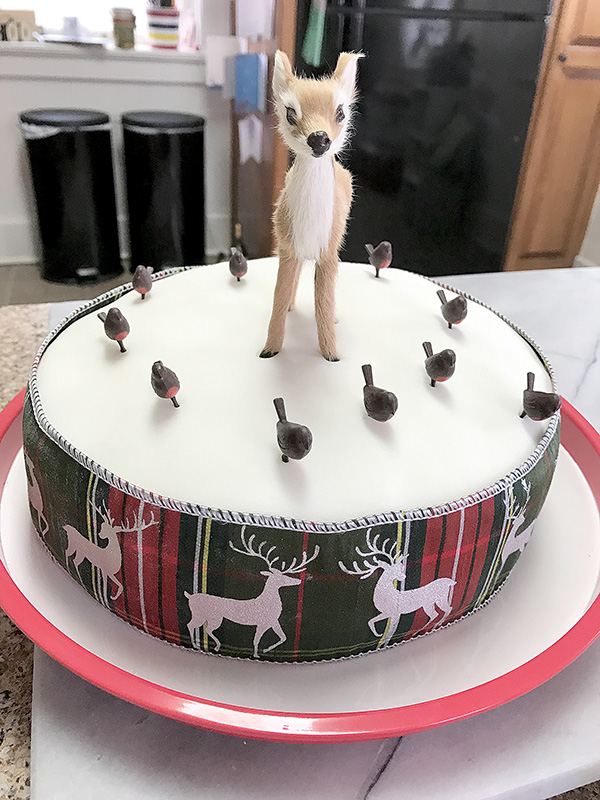
By Eileen Moon
It was just after 4 p.m. when I unscrewed the top on the bottle of Jameson whiskey.
It wasn’t deep winter yet, but summer was surely past, the leaves had turned. The sun sat lower in the sky, and all that meant one thing: Time to make the Christmas cake.
I’d never made one before. It was, after all, a fruitcake, and there are so many jokes about fruitcakes that it’s difficult to think the world might need another one.
But on the other side of the argument, there is my cousin.
For as long as I’ve known her, which isn’t as long as you might think – she has made a Christmas cake every year, an endeavor she begins many weeks before Christmas.
Valerie lives in Ireland, however, where Christmas cakes are as critical to Christmas as a burger is to a Kansas barbecue.
I’d known of Valerie for years, as a name and address on a sheet of lined paper that had holes punched in the side so you could slip it into the ring binder you carried to school. One of my American cousins, off on an adventure made affordable by the Youth Pass airlines offered in the 1970s for roving college students, had visited our Irish and English cousins in those long-ago carefree days, writing their names and ages and addresses down in the Peacock blue ballpoint ink she favored then.
It was a reconnection many years in the making, for our mutual grandfather had left the Emerald Isle in 1908 to make his way in America. And he made his way, but it never led back to Ireland, where his brothers and sisters – the ones who had stayed there, anyway – forged lives of their own.
Time passes in that way, little by little, day by day, and so he never went home. He kept in touch, though, and his daughter – my mother – wrote back and forth during the years of her childhood with a cousin – Valerie’s mother – who shared her first name.
My grandfather died too young for us to know him, and life moved in its own direction, the roads turning here and there with war and trouble and times both happy and sad. And in that way, the connections that once crossed the sea by letter and bloodline and light of memory grew faint and flickered into the dim past. First, our grandfather’s generation left us. And with time, our parents – his children’s generation – the first cousins, began to leave us, too.
But still we had the history; notes and photos here and there, stories and mysteries, stretching both back and forward into the vast unknown.
One day, poking around on an international genealogy site on the internet, I came across someone else researching our family name. And suddenly, Valerie and I, just a few years difference in our ages, re-forged the link.
It is a strange thing how time loops in and out of our lives, ribbons around, unravels, returns. As big a mystery as how a mixture of seemingly unrelated lives can somehow coalesce into a family.
Which brings me back to the Christmas cake. A few years ago, now, Valerie sent me pictures of her cake-in-progress, explaining the weeks-long making-of-the-cake from its birth as a bowl of candied fruit and chopped nuts through its eventual evolution into a magnificent centerpiece of the Christmas table.
It was an impressive achievement, and one I might never have thought to duplicate were it not for the two years of pandemic-inspired kitchen time and a deepening respect for my ancestors, who worked and struggled, risked and traveled, and made their hard times sweet.
The recipe Valerie has used for the past 46 Christmases is one that was published in a school cookery book. It appeared for the first time in 1915.

Her mother’s Christmas cake was a different animal all together. “She had her own recipe – or lack of recipe. A cup of this, a cup of that. A pinch of this and a drop of that. It always turned out well. (It was a) lovely fruitcake,” explained Valerie. But it was missing what is, to her, a key ingredient: frosting.
“She had a horror of white icing and would only ever put marzipan or almond icing on it. Needless to remark, we always felt deprived and were always yearning for white icing.”
Valerie’s cake, in contrast, is crowned with a fluffy ocean of icing perfect for placing little Christmas figures in.
There are many recipes for Christmas Cake but there are certain points of intersection: Most importantly, you need to allow yourself enough time. The chopping and mixing will take a day or two. The assembly and baking of the cake, another. Once it is out of its lengthy sojourn in the oven, you’ll be unwrapping it from its nest to feed the cake a little more whiskey every week or so.
This means you need to get started several weeks before Christmas. In Ireland and the U.K., I learned recently, the last Sunday in November is known as “Stir up Sunday.” It’s the day for starting your Christmas baking. But you may want to start the Christmas cake even earlier than that.
And well before that, you’ll need to begin assembling the ingredients. Certainly, substitutions can be made, but if you are hoping for authenticity, you may need to consider the long divide of the Atlantic Ocean, and order some of your ingredients from afar.
You will need a small parade of spices, some candied cherries. Currants and raisins. Almonds and marzipan. Golden syrup. Candied peel.
It’s not an inexpensive cake to make, but this is Christmas, after all. Many of its ingredients are native to the world’s exotic places – islands where the wind is flavored with the scents of spice, orchards where the branches droop with the weight of fruit. Imagine what an amazing thing a Christmas Cake would be in the days before Amazon deliveries, when fortunes were made on imports from far-off places.
And yet we know that Christmas can’t be bought. It must be made. Made with a friendship. Made with a gift. Made with a word. Made with a song. Made with a feeling. Made with a cake.
All this abundance, all these exotic travelers from those far-off places in the world, arrive at your doorstep now to take their places in the cake, making it into something it would not be without their presence in it.
Ireland, too, is a land of travelers. Several years ago, when Valerie’s son was working in Australia, she went to visit him. Even though it was July, she knew he’d missed the Christmas cake, and so she made a small one to take along. Knowing Australian customs requirements were strict, if Valerie had to sacrifice the cake to security, she would at least have tried. So, she declared the cake on the forms filled out before leaving the plane and entered Australia.
There she stood by the conveyor belt in the airport surrounded by hand luggage as security dogs in fluorescent yellow jackets that read “Border Patrol,” sniffed their way through the luggage. Twice, the dog stopped and put his paws on the bag with the Christmas cake. A guard approached and asked Valerie what was in the bag.
“I hope you put a lot of whiskey in it,” he said with a smile. Valerie – and the cake – were free to go.
There are many recipes for Irish Christmas cake easily found on the web. The website dochara.com features step-by-step instructions for a Traditional Irish Christmas Cake that includes American measurements. World Market in Shrewsbury has both golden syrup and marzipan on shelves now. Harder to find were candied cherries and currants, which I ordered on Amazon.
Traditional
Irish Christmas Cake
1 pound sultanas
½ pound raisins
½ pound currants
4 ounces glacé (candied) cherries,
halved or whole, not chopped
2 ounces mixed candied peel, finely chopped
½ teaspoon ground mixed spice
½ teaspoon cinnamon
½ teaspoon vanilla
1 lemon, zested and juiced
1 orange, zested and juiced
1 large or 2 small apples, finely grated
3 ounces slivered almonds
1 tablespoon Golden syrup
4 tablespoons Irish whiskey
10 ounces Irish butter
8 ounces soft brown sugar
5 eggs
10 ounces all-purpose flour
2 ounces ground almonds
½ teaspoon salt
Prepare the fruit. The night before you intend to bake the cake, put all the ingredients down to and including the whiskey into a bowl and mix well.
Cover and leave to soak overnight. Do NOT be tempted to skip this pre-soaking as it adds immensely to the moistness of the finished cake.
The next day, preheat the oven to 300°F; 280°F convection.
Line a cake tin carefully with parchment paper smeared with butter. Let the paper extend a little over the top of the cake tin. Fold another length of parchment paper so that you have a long rectangle of paper several layers thick. Wrap this collar around the outside of the tin and tie it securely in place with string. Your tin should now be almost invisible – sandwiched between a layer of paper on the outside and the inside.
Fold another piece of parchment in half and cut out a round about the size of your cake tin. In the center of this double sheet make two cuts about 2 inches long in the shape of a cross. Set this and the tin aside.
Put the butter and sugar into a bowl and whisk with the mixer until it turns a pale color. Add the eggs one at a time, mixing well before adding the next, as the mixture can easily curdle at this stage.
Mix the flour, ground almonds and salt together and then fold into the butter/sugar/egg mix – don’t use a mixer for this. Add the fruit and mix everything up well – again by hand or with a wooden spoon, no mixer. The resulting mixture will be thick and quite sticky.
Spoon the mix into the lined cake tin. Smooth the surface using a large metal spoon dipped in cold water, so that the mix is slightly higher around the edges of the tin than it is in the center.
Tuck the square of silicone paper with the cross shaped cut in it loosely over the top of the cake – this will stop the top from browning too much.
Bake for 3 ½ hours, then check for doneness by inserting a metal skewer into the center of the cake – if it comes out dry the cake is done; if not, put it back in the oven for another 30 minutes. It can take up to 4 ½ hours for the cake to be completely cooked.
When the cake is done, set it aside to cool completely in the tin until the next day.
On day three, carefully remove the cake from the tin by easing a palette knife between the cake tin and the lining paper. Then peel the lining paper off the cake.
Give the cake its first “feed” of whiskey. Turn it upside down and pierce it in 5-6 places with a thick skewer. Pour about half a teaspoon of whiskey into each hole – it won’t be very accurate, but don’t worry, it’ll soak in anyway.
Repeat this feeding process every week to 10 days in the run-up to Christmas – maybe 4-6 feeds in all. Between feedings wrap the cake tightly in a layer of parchment paper and aluminum foil, then place in an airtight container.
You can leave the cake plain or ice it with two layers a few days before Christmas, first with a thin marzipan layer, followed by a layer of white royal icing. Decorate in a “Christmasy” way, using ribbon, ornaments, holly leaves and berries or additional icing.
(Recipe adapted from dochara.com.)
The article originally appeared in the December 2 – 8, 2021 print edition of The Two River Times.














